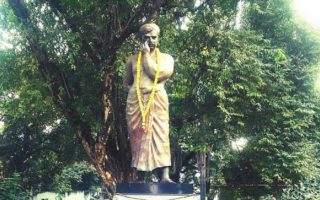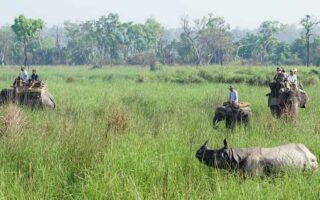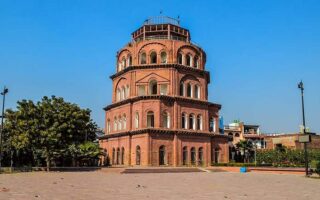- Situated: Agra, Uttar Pradesh, (India)
- Constructed By: Emperor Akbar
- Constructed in: 1571-1585
- Entry Fees and Timings: Foreigners-(Rs 550), Indians-(Rs40), Open all days
Fatehpur Sikri is located 37km away in the southwest direction of the Agra city .It is a Mughal City, which is still preserved, and it is always recommended to have a look at this massive and beautiful city. The name Sikri indicates Shukriya (thanks to the Almighty (Allah) and is an Urdu word. This was originally uttered by Emperor Babar when he attended victory over Rajputs. But at present only the word Sikri related to Babur is present.
The name was extended to Fatehpur by Emperor Akbar s he conquered Gujarat. This town was established to mark his Gujarat triumph. Fatehpur Sikri was the capital city when Emperor Akbar was in power between 1570-1586.But due to the shortage of water, Akbar was forced to move his capital to Agra and this city was left out.
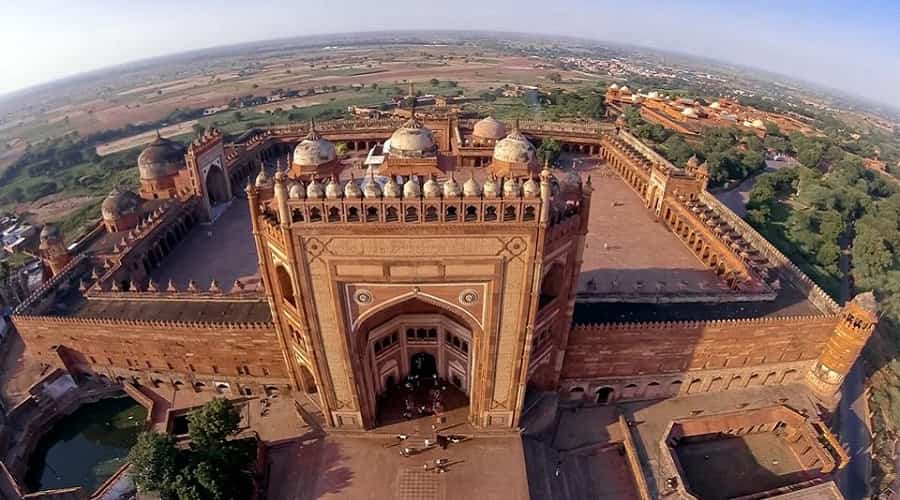
It is said that Akbar’s serail was poured with approximately 800 members and many begums but Emperor Akbar was still without a male successor. Emperor Akbar had visited Muslim Saint Shaikh Salim Chisti at Fatehpur Sikri with the desire to get a male child. By the grace of Salim Chisti, one of Emperor Akbar’s wife Jodha Bai endured him a male child. As a token of appreciation, Akbar named his son Salim and had again shifted back to Fatehpur, the birthplace of Fakir.
Emperor Akbar raised up a fortress on the top of the hill in the year 1569.A huge township was formulated around it. Emperor Akbar had raised his palace on the top of the hill. The palace was by high walls on three sides and an artificial lake which was about 20 miles covering the fourth side. The brand new capital was constructed with a fine flux of Muslim and Hindu architectural styles. The structures were known to change colors from pink to red as the days passed by. The prime entrance to this magnificent town was through Shahi Darwaza, which is located to the eastern direction. Fatehpur Sikri is one of the best example of Mughal Architecture. This city at present is in ruins but the art is still alive and is a must visit when you come to Agra as the sunset above the ruin is magnificent view to cherish.
- Also Read: Best Places to Visit in Agra
Visitors Attraction
Diwan-i-Aam

As you, enter to the northeastern side of the city of Fatehpur Sikri you will find Diwan-I-Aam also called as Hall of Public Audience. During that time, Emperor Akbar used to present himself in front of the public every morning. This building comprises of a lustrous courtyard, which is bordered by cloisters. There is also a big Pachisi Courtyard that looks like a huge games board. Believers believe that Emperor Akbar used to play board games using slave girls apparelled in blue, red and yellow colors.
Ibadat Khana
Near to this massive structure is the Ibadat Khana also known as the hall of religious discussions. This place is adorned beautifully in Hindu style of architecture. Din-i Ilahi was preached by Emperor Akbar and originated from (Ibadat Khana).
Diwan-I-Khas
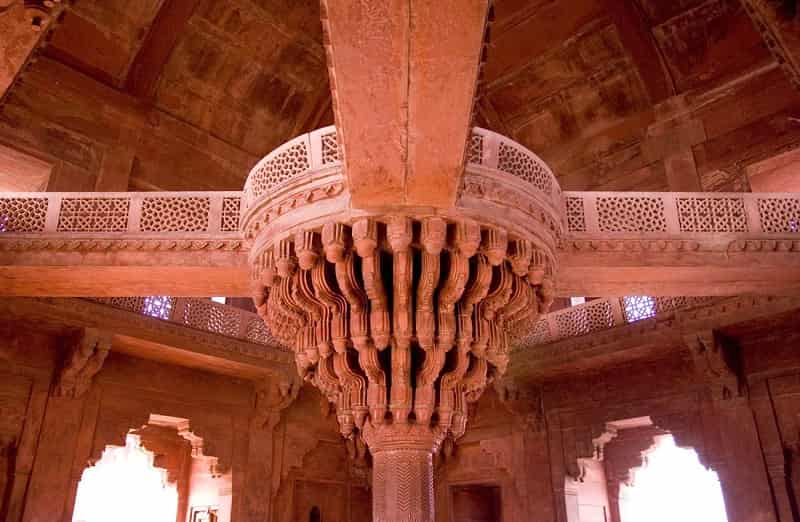
Diwan-i-Khas also known as Hall of Private Audience is a 2 storeyed building. This structure was specially constructed for the main ministers of the emperor Akbar.
The exterior side of this structure is quite simple, but the interior section is unique and impressive. This structure also 2 columns which is elegantly ornamented also supports the throne. From the 4 corners of the spacious room, bridges of stones lead the path to this huge throne. It is believed that Emperor Akbar used to sit here and his ministers surrounding him.
Jami Mosque (Dargah Mosque)
This Mosque is said to be a replication of the holy mosque at Mecca. This building is a blend of Persian and Hindu architectural style. You will enter the mosque trough the huge Buland Darwaza, which is 54mts high. The Buland Darwaza, is also known as The Gate of Victory. This massive construction was built in the year 1573 to mark the Emperor’s victory of Gujarat. You can also reach this massive gateway through a 13mts extravagant staircase. Next, you will see an inscription from the Holy Quran means, “The world is a bridge, pass over it, but build no house upon it. He who hopes for an hour may hope for eternity.” There is a deep well outside the Buland Darwaza, which is a famous spot and always mongered by tourists.
Jami Mosque so big that it has the capacity to hold approximately 10,000 people at a time. Inside this huge mosque, you will find a tomb of Shaikh Salim Chisti. This Dargah is constructed in sandstone and an epitome of Mughal Architecture. This Dargah was built by Akbar in the year 1571 as Salim Chisti died, to pay homage to this sacred saint. As because of this saints blessing Akbar got his male child, many childless women still visits this Dargah in the hope of a child. The death anniversary of Sheikh Salim Chisti is celebrated in winters every year.
Palace of Queen Jodha Bai also known as Hawa Mahal :
As you head to the northeastern direction, you will find the palaces of Jodha Bai, the mother of Prince Salim and Emperor Akbar’s Hindu wife. This architectural palace is a flux of Muslim and Hindu art as you will see cupolas and columns. As you enter this magnificent palace, (Palaces of Wind) the rooms are designed with original latticework done on stones. During the era of Mughal, this Mahal was used by the women to have a glance on the events below.
Birbal Bhawan

This Bhawan is situated near to the Hawa Mahal, and it is said that this massive structure was constructed either by or for Birbal, one of Emperor Akbar’s most loved courtier. This Bhawan is comparatively smaller in size amongst all the other huge structures. Nevertheless, the beautiful stone carvings and designs will attract you. The Victorian era famous French author had commented about this massive structure that either it is smaller in size or else it is a huge jewellery box.
Hiran Minar and Karawan Sarai
Hiran Minar and Karawan Sarai are two of the other tourist attraction at Fatehpur Sikri. During the time Of Emperor Akbar Karawan Sarai also known as Caravanserai was a huge courtyard layed by hostels or Visiting merchants who came to the town. Hiran Minar also known as Deer Minaret is said to be constructed over the royal grave of Emperor Akbar’s beloved elephant. You will find tusks of stone elephant from the high tower measuring 21m.From the top of this building it is said that Emperor Akbar used to shoot Deer and other animals brought in front of him.
Mariam’s House
The other name for this house is Golden House that was constructed nearby Jodha Bai Palace. This house was used by Emperor Akbar’s Christian wife whose name was Mariam from Goa. This palace as gilded and also known as Sunehra Mahal.
Turkish Sultana’s House
This house is located to the left side of the Pachisi Board. The carving shows relevance of central Asian architecture and the geometrical pattern, which is carved on the ceiling, is magnificent.
Panch Mahal

Panch Mahal also known as the 5 storey Palace. This building is built in Persian architecture that looks a Buddhist Monastery. This building tapers towards the roof and the structure looks like a tiny kiosk. The pillars of the building are not the same. The dome of this building looks like a crown on the top of the structure. The stone screens were used by the women’s or was used to conduct assembly. You can have a bird’s eye view of the fort from the top but it is suggested not to climb the stairs as it is in uneven condition.
Ankh Michauli
Ankh Michauli also known as hide and seek. This place was used by the Emperor to play hide and seek with his rani’s (queens).This building is located in the south western direction of Diwan-i-khas. This building is also known as treasure pavilion. This building also used as record room and has some amazing stone carvings. Ankh Michauli was always heavily guarded by soldiers.
Daulat Khana-i-Khas
This was the Emperor Akbar’s private chamber. This building has 2 primary rooms on the ground rooms. The smaller room was considered as emperor’s library and the large room is said to be emperor’s rest room. The bedchamber or the Khwabgah is on the first floor of this building. This building was connected to the Panch Mahal, The Jodha Bai’s Palace and Turkish Sultana’s house by corridors.
